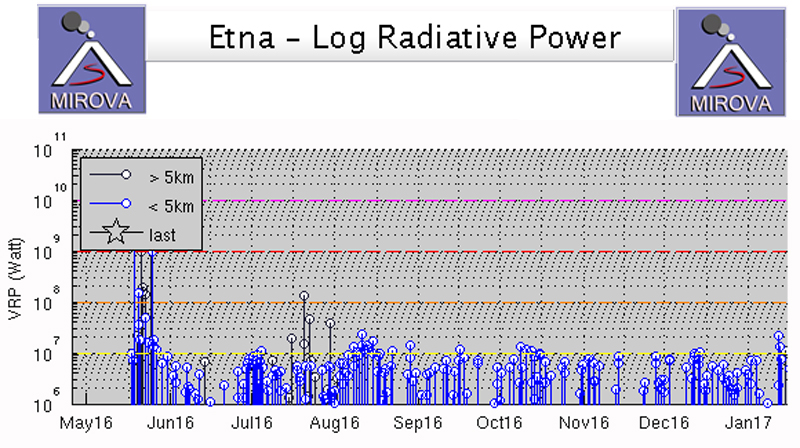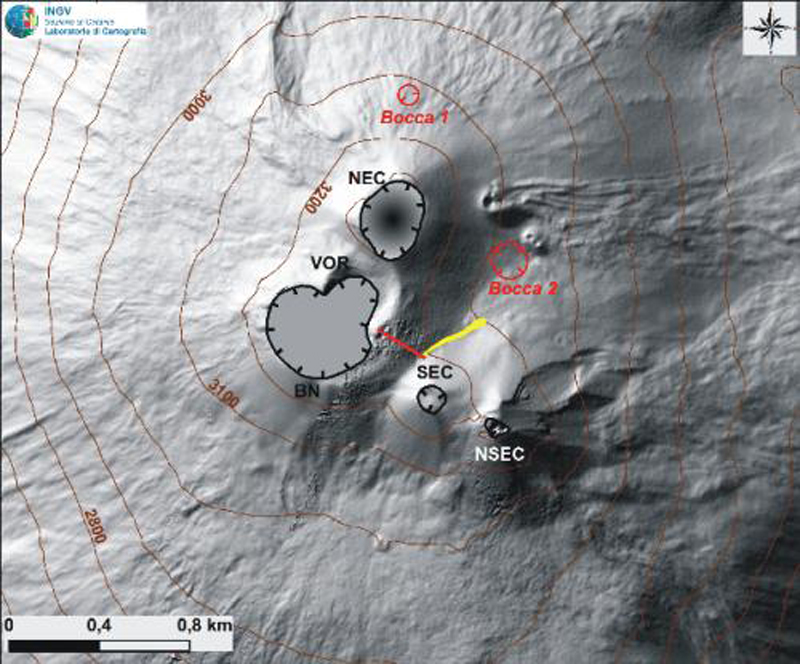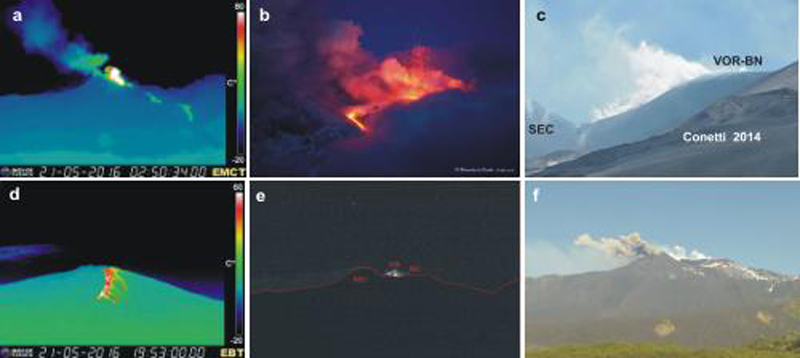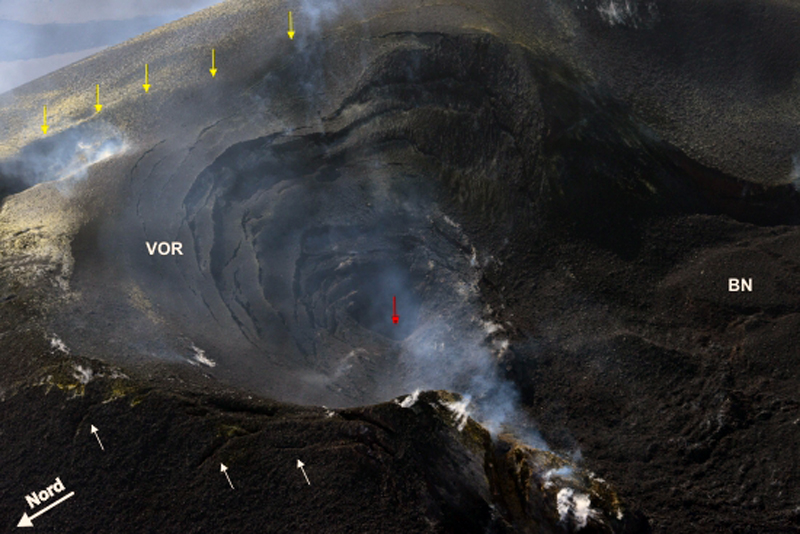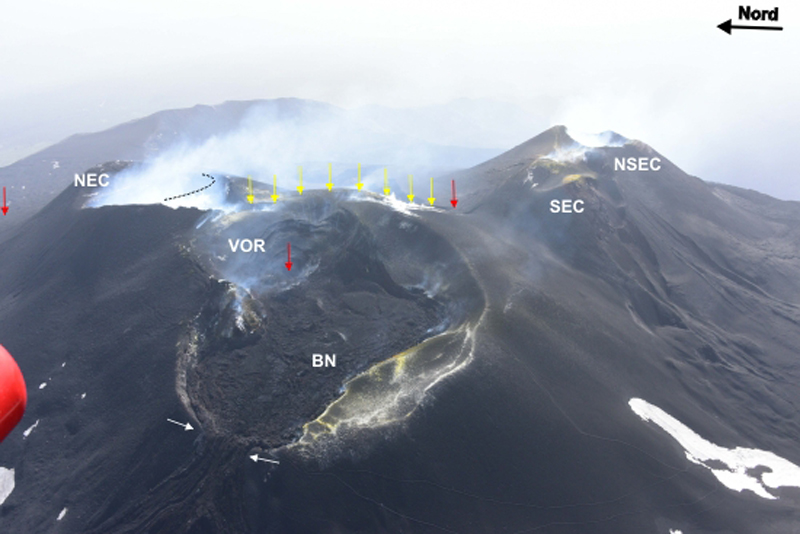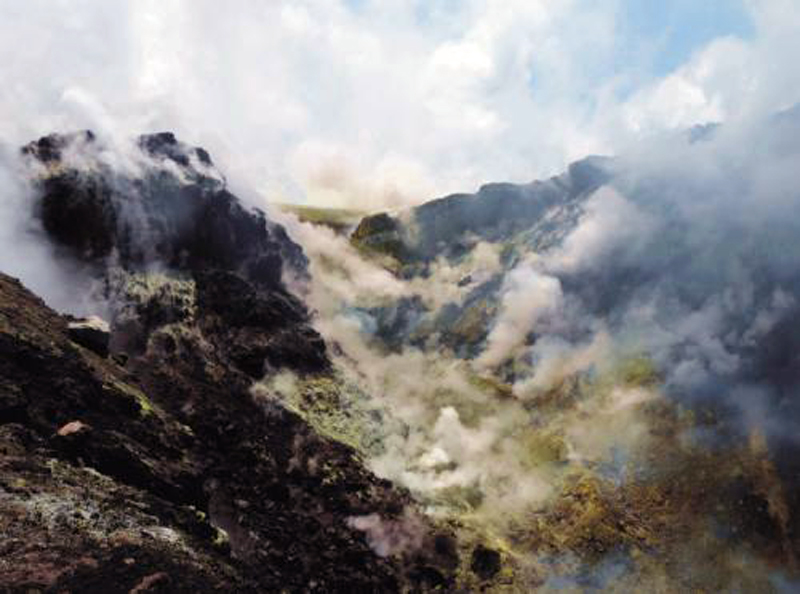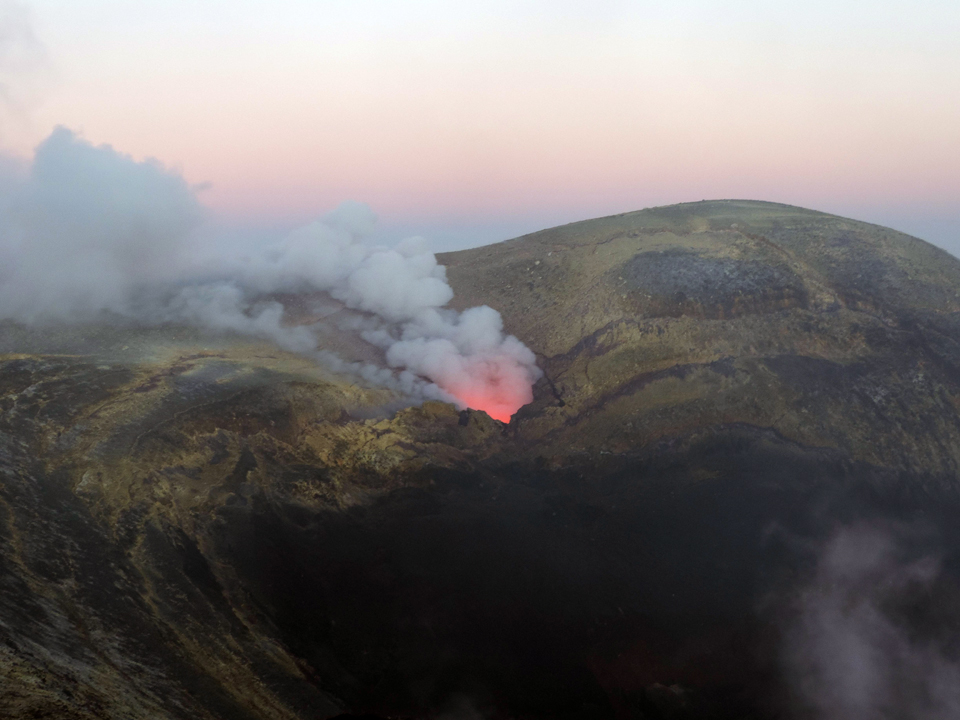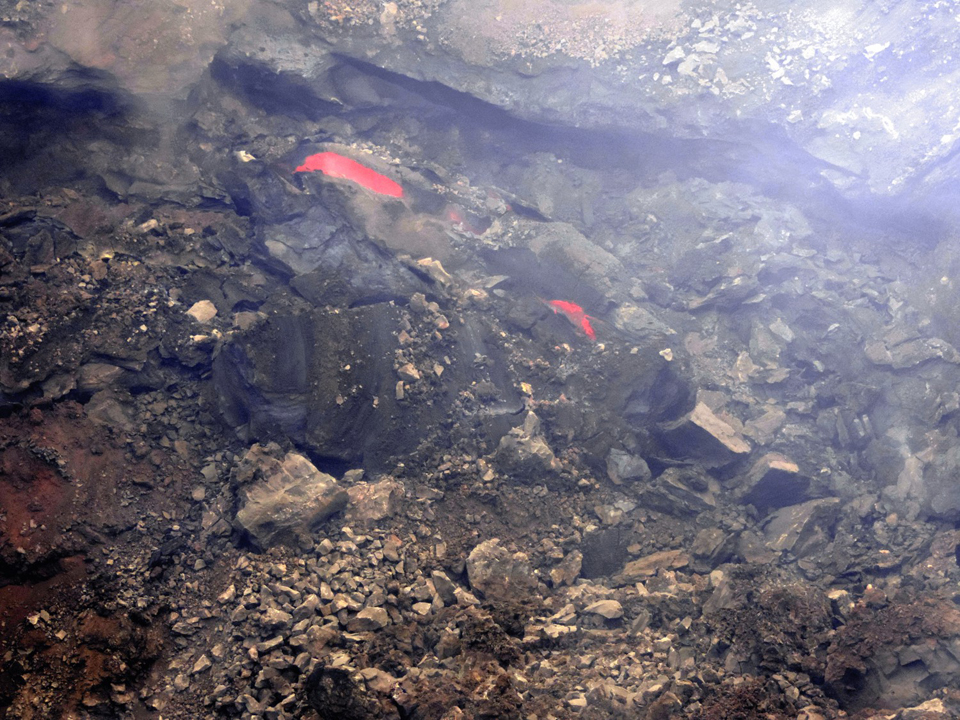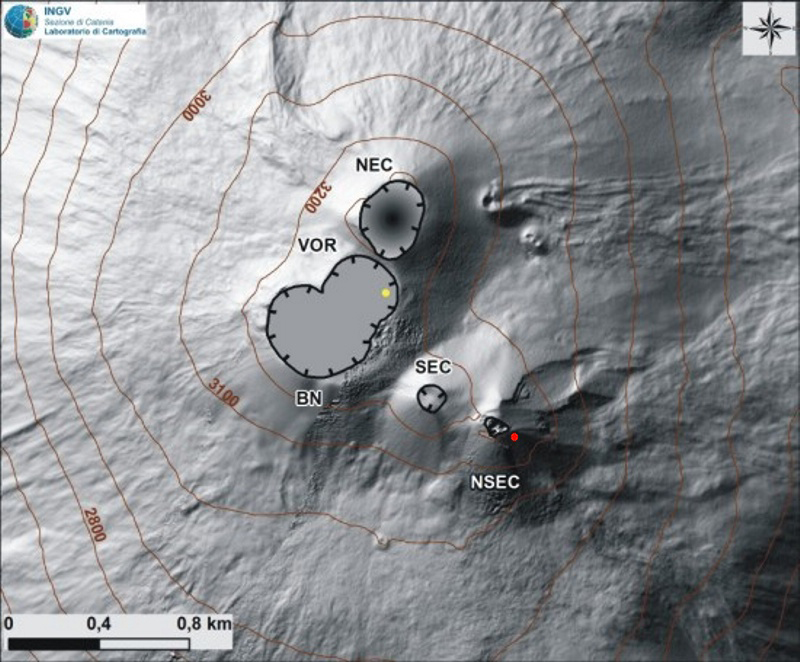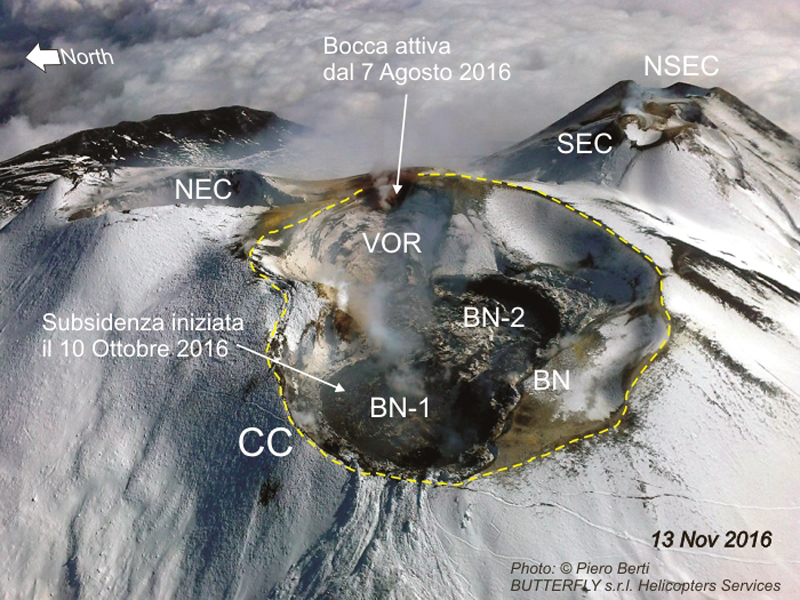Report on Etna (Italy) — September 2017
Bulletin of the Global Volcanism Network, vol. 42, no. 9 (September 2017)
Managing Editor: Edward Venzke.
Edited by A. Elizabeth Crafford.
Etna (Italy) Lava flows during May 2016 followed by new fracture zones and major subsidence at the summit craters
Please cite this report as:
Global Volcanism Program, 2017. Report on Etna (Italy) (Crafford, A.E., and Venzke, E., eds.). Bulletin of the Global Volcanism Network, 42:9. Smithsonian Institution. https://doi.org/10.5479/si.GVP.BGVN201709-211060
Etna
Italy
37.748°N, 14.999°E; summit elev. 3357 m
All times are local (unless otherwise noted)
Italy's Mount Etna on the island of Sicily has had historically recorded eruptions for the past 3,500 years. Lava flows, explosive eruptions with ash plumes, and lava fountains commonly occur from its major summit crater areas, the North East Crater (NEC), the Voragine-Bocca Nuova complex (VOR-BN), the South East Crater (SEC) (formed in 1978), and the New South East Crater (NSEC) (formed in 2011). The Etna Observatory, which provides weekly reports and special updates on activity, is run by the Catania Branch of Italy's Istituo Nazionale di Geofisica e Vulcanologica (INGV). This report uses information from INGV to provide a detailed summary of events between April 2016 and January 2017.
Summary of April 2016-January 2017 activity. A new eruptive episode at Etna began on 15 May 2016 and included activity around all four major summit cones; Strombolian activity began at NSEC on 15-16 May, from a pit on the E flank of the cone. The following night, thermal webcams suggested Strombolian activity at NEC. This ceased on 18 May when Strombolian activity started at VOR that also produced a large ash plume. Lava then overflowed the W rim of BN and headed W multiple times during the next few days. A different flow emerged from a fracture on the SE side of VOR near SEC on 21 May. Activity from all of the active vents had ended by 26 May. New fracture zones trending N-S and NE-SW, and extensive subsidence within VOR were observed at the summit craters at the end of May after the episode ceased.
Intermittent weak ash emissions during late May and July and intense degassing from several craters were the primary activity until explosive activity at VOR began on 7 August and opened a new vent along the inner wall of the NE rim. Strong subsidence followed at VOR and BN during August and September, creating a single large crater that included both areas. Dense ash emissions from the vent on the upper E flank of NSEC in mid-October and a few modest ash emissions from VOR and NSEC were observed. There was also persistent incandescence from the new vent at VOR and its continued subsidence through early January 2017. After the spike in activity during May 2016, heat flow diminished, but was persistent throughout the period (figure 174).
Activity during March-April 2016. After the major lava fountains and ash plumes of the first week of December 2015 (BGVN 42:05), eruptive activity was lower through March 2016. Sporadic ash emissions and minor incandescence were reported a few times each month. The largest event was an explosion on 23 February 2016; it produced an ash plume that drifted NE and caused ashfall in communities as far as 40 km away.
Continuous degassing accompanied dense ash emissions from the North East Crater (NEC) and the New South East Crater (NSEC) during 31 March-1 April 2016. Winds sent material to the SW, and then changed direction to the N the following day, dispersing pyroclastic material around the crater area. Ash emissions continued to be weak but persistent for the rest of April from NEC and NSEC, while only minor degassing was observed from the Voragine-Bocca Nuova complex (VOR-BN). A new pit crater was observed near the center of BN from the gradual collapse of the crater between 19 February and 15 April 2016.
Activity during May 2016. Although visibility was limited due to weather in early May 2016, discontinuous explosive activity with minor ash emissions was observed over several days from NEC and NSEC near the top of Valle del Bove (a large valley SE of the summit crater area). Weak incandescence from NSEC was detected by the high-resolution webcam at Monte Cagliato for the first time in several months during the night of 16 May, and marked the beginning of a new eruptive episode that lasted until 25 May 2016, involving activity at all four summit crater areas (figure 175).
Explosive activity first observed during the night of 15-16 May 2016 at NSEC came from a pit on the E flank of the cone. The following night, webcams also showed a thermal anomaly at NEC, interpreted by INGV as probable Strombolian activity. At first light on 17 May, intense degassing was observed from NEC which lasted throughout the day and included minor ash emissions. Strong explosions from NEC were heard about 10 km from the crater. Strombolian activity rising tens of meters above the rim was first observed around 2000 UTC. During the night of 17-18 May, intermittent flashes, likely from explosive activity, originated from the pit on the E flank of NSEC.
Continued explosions at NEC during the morning of 18 May produced an ash cloud that drifted ESE. This activity ceased around 1050 UTC, when Strombolian activity began at VOR that rapidly evolved into a lava fountain. The activity also created an ash plume that rose to an altitude of 7 km and drifted due E. The lava fountain continued until about 1430 UTC. Shortly after the Strombolian activity began at VOR (around 1100 UTC), lava overflowed the W rim of BN and headed W towards Monte Nunziata. It traveled for about 2 km and stopped at an elevation of around 2,100 m based on observations from the Bronte thermal webcam. Also at 1100 UTC, a small explosive vent opened at the base of the N side of NEC (Bocca 1 in red, figure 175) that spattered for a few minutes. Around 1530 UTC, an improvement in weather conditions permitted observation of a new lava flow in the Valle del Bove. The flow, fed by a vent at the base of the E side of NEC (Bocca 2 in red, figure 175), headed E towards Monte Simone, and stopped at an elevation of approximately 2,400 m.
By the morning of 19 May, although adverse weather conditions prevented observations, a sudden increase in the amplitude of tremor and loud explosions heard in communities E and S of the volcano suggested another explosive episode at VOR. A dense eruptive cloud drifted E. A new lava flow emerged from the W rim of BN, and headed W on top of the flow from the previous day. It divided into several arms, the longest of which flowed about 1,800 m, near Monte Nunziata, without reaching the nearby highway. Strombolian activity was again observed at VOR beginning around 1900 UTC on 20 May when weather conditions improved.
Beginning around 0140 UTC on 21 May 2016, a rapid escalation of the amplitude of volcanic tremor occurred together with increased explosions from VOR. Around 0200 a small lava flow was observed from a fracture at the base of the SE side of the cone of VOR near the base of SEC (the yellow flow marked on figure 175). The intense explosive activity at VOR generated a plume that drifted S. Tremor amplitude decreased suddenly around 0600. Lava was observed overflowing the W rim of BN around 0700, covering the flows of the previous days. Strombolian activity was again observed from VOR during the night of 21-22 May. Sporadic ash emissions from the pit on the E flank of NSEC during the early morning of 22 May quickly dissipated. That afternoon, renewed Strombolian activity began at NEC which intensified and then ended during the following night (figure 176).
A new round of weak Strombolian activity began at VOR around 1900 on 23 May 2016. Activity continued until 1750 on 24 May when explosive activity increased sharply. Vigorous Strombolian activity peaked during the night of 24-25 May. Incandescent material rose a few hundred meters into the air, and mostly fell back into the crater. It was not accompanied by a lava flow or ash plume. Activity began decreasing during the afternoon of 25 May, and ceased sometime during the following night. Both ground-based and aerial observations by INGV personnel on 26 and 27 May confirmed the end of the eruptive episode and documented its effects (figure 177).
A N-S trending fracture zone about 400 m wide and 1,300 m long was observed extending S beginning at the northern side of NEC, crossing the E rim of the Central Crater (the combined VOR-BN complex), where it changes direction and extends SE toward the SEC (figure 178). A vent at the base of the saddle between SEC and VOR fed weak effusive activity on 21 May. Tens of meters of collapse within the graben contributed to the destruction of the S rim of NEC, significantly changing its shape and filling it with debris.
Major subsidence at VOR after the end of the Strombolian activity of 23-26 May 2016 created numerous sub-circular concentric fractures within the crater with a vent degassing at the base (figure 179). The BN area was filled with the eruptive material that had overflowed the W rim (figure 180).
Activity during June 2016-January 2017.A weak ash emission from VOR on the morning of 31 May 2016 was the only additional eruptive activity during May. INGV volcanologists making ground observations on 3 June noted about 10 m of subsidence of the lava surface filling BN and continued collapse at the center of VOR. Intense degassing of mostly water vapor occurred from the fracture on the SE side of VOR. Strong degassing continued from all the new fracture zones at the summit during June and July. Ground-based thermal imagery recorded on 16 June indicated temperatures as high as 300°C around the fractures within the Central Crater. A helicopter overflight on 14 July showed few changes in the graben system first documented at the end of May, except for continued collapse near the S rim of NEC. Minor ash emissions resumed at NSEC; they were observed during 10-14, 19-21, and 26-28 July. Explosions were heard from the W side of BN during a visit by INGV scientists on 28 July.
Intense and persistent degassing continued during August 2016 from NEC and from the fractures between NEC and VOR (figure 181). Incandescence was observed within the fractures on 4 August. NSEC produced minor ash emissions again during 4-5 August. Low intensity explosive activity began at VOR on 7 August, but no material was ejected beyond the crater rim. An incandescent vent was observed within the collapsed inner wall of VOR on 10 August (figure 182). Explosive activity and incandescence was intermittent from this vent during 7-22 August. The apparent temperature at the vent as measured by thermal camera was greater than 580°C on 22 August. Weak and episodic ash emissions also occurred from a vent on the upper E side of NSEC on 27 and 29 August. Incandescent degassing continued at the 7 August VOR vent throughout September, along with persistent fumarolic emissions from the fracture zones.
A series of low-frequency seismic events were recorded at the summit on 10 October, some accompanied by explosive sounds. The strongest seismic event produced ash and hot gas that was recorded by two thermal cameras during the early afternoon. The ash rose from the W part of BN about 100 m above the rim and drifted rapidly E. During an inspection on 12 October, INGV scientists noted that subsidence of about 50 m had occurred within the BN, centered near the W crater wall, and was ongoing. They observed the sudden dropping of material along concentric fractures accompanied by reddish ash and modest steam emissions. One of these events exposed an incandescent area within the fresh lava (figure 183).
Dense ash emissions were produced on 17 October from the 25 November 2015 vent on the upper E flank of the NSEC (figure 184). A diffuse brown ash plume was observed the next day during a field inspection of the area. Intermittent diffuse brown ash emissions were again observed on 6 November. Persistent fumaroles from the vent at VOR and bottom subsidence at BN continued during November where two distinct areas of subsidence (BN-1 and BN-2) were visible (figure 185).
Intermittent, low-intensity incandescence at the VOR vent appeared during the night of 28-29 November 2016. Sporadic, minor ash emissions occurred from the saddle area between SEC and NSEC during 15 December. Incandescence that evening from the VOR vent was also recorded on the webcams. A light coating of ash and a few lithic blocks appeared the next morning in the fresh snow on the flank of the SEC. Modest ash emissions from the same area continued intermittently through the end of December. On 31 December, a diffuse ash plume was also noted from the vent on the upper E flank of NSEC. Sporadic incandescence continued from the VOR vent during early January 2017.
Geological Summary. Mount Etna, towering above Catania on the island of Sicily, has one of the world's longest documented records of volcanism, dating back to 1500 BCE. Historical lava flows of basaltic composition cover much of the surface of this massive volcano, whose edifice is the highest and most voluminous in Italy. The Mongibello stratovolcano, truncated by several small calderas, was constructed during the late Pleistocene and Holocene over an older shield volcano. The most prominent morphological feature of Etna is the Valle del Bove, a 5 x 10 km caldera open to the east. Two styles of eruptive activity typically occur, sometimes simultaneously. Persistent explosive eruptions, sometimes with minor lava emissions, take place from one or more summit craters. Flank vents, typically with higher effusion rates, are less frequently active and originate from fissures that open progressively downward from near the summit (usually accompanied by Strombolian eruptions at the upper end). Cinder cones are commonly constructed over the vents of lower-flank lava flows. Lava flows extend to the foot of the volcano on all sides and have reached the sea over a broad area on the SE flank.
Information Contacts: Sezione di Catania - Osservatorio Etneo, Istituto Nazionale di Geofisica e Vulcanologia (INGV), Sezione di Catania, Piazza Roma 2, 95123 Catania, Italy (URL: http://www.ct.ingv.it/it/); MIROVA (Middle InfraRed Observation of Volcanic Activity), a collaborative project between the Universities of Turin and Florence (Italy) supported by the Centre for Volcanic Risk of the Italian Civil Protection Department (URL: http://www.mirovaweb.it/).


